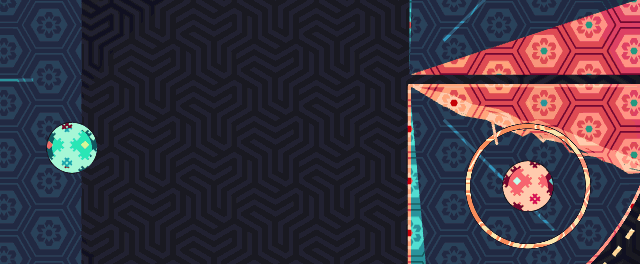JUMP TO
Introduction / Fundamentals / Dash / Cut / Wind / Ghost / Shoot / Poke / Nest / Pulse / Leech / Stim / Corp
PREVIOUS: Cut
WIND
Wind plays similarly to Dash in terms of strategy. The efficacy
of each highly depends upon level layout and their overall success
relies on correctly reading the opponent's movement.
Personally, I believe Wind more useful at low levels of play than
high. New players tend to struggle reacting to Wind, given their
relatively undeveloped spatial and situational awareness compared
to experienced players. Wind pushes such players into cutlines with
relative ease (and makes crushing rocks seem such a breeze).

As both Dash and Wind affect the opponent's momentum, many of the
tactics covered in the Dash section apply to Wind as well. I'll note,
however, that Wind's power does not scale according to your distance
from the opponent, as it would with Dash. Therefore, you may activate
Wind from directly beside the opponent in situations where you'd be
forced to retreat as Dash. This allows you to better pressure the
defender with your presence, as well as making Wind's activation
generally less telegraphed than Dash's.
However, while Wind may be difficult to anticipate, it is easy to react
to. Upon initiation, Wind pushes at only half-strength, and will not
push at full strength until it finishes deploying. The defender has
plenty of time to begin moving against it.
Once you've successfully pushed the defender against a cutline, the ball
will often remain pinned there by the windstream. In such situations, new
Wind players frequently struggle to free the ball, opting instead to rush
in and pick it up, accidentally throwing themselves against the cutline as
well. Remember that once the defender drops the ball, they will remain
stunned long enough that you may comfortably throw wind in some other
direction before collecting the ball.

You should understand, as well, the ways in which Wind tends to frustrate
players, making them anxious and impatient to steal. Try, for example, to
hover in the center of a windstream as the defender. One can easily hold
still at any random point within a windstream, but to match another player's
specific position is much more difficult. When the attacker enters the
windstream to approach you, it will often be in such a way that they pass
you by, remaining in range to steal only for a short time. Seeing as it takes
them such effort to return to your position, and because they'll spend so
little time in range anyway, a fear of lost opportunity will frequently possess
them, leading them to steal. Even if they don't steal, it will likely take
them long enough to reach you again that your shield will have time to recover
from a short block. Obviously, all this depends on your opponent's inability to
navigate the windstream. If this doesn't give them trouble, the whole gambit
is only minimally effective.
There are many such tiny, situational uses for wind. It can be used to
"dribble" a ball from one side of the map to the other faster than you
could carry it. Cut can slide along a windstream to rapidly increase the
length of its cutline. If another player is closing in on you, a windstream
can provide a means of retreat they might anticipate. Wind may indeed benefit
you on occasion, but an experienced player should easily react to most of
Wind's uses, drastically reducing its efficacy at a high level.
NEXT: Ghost